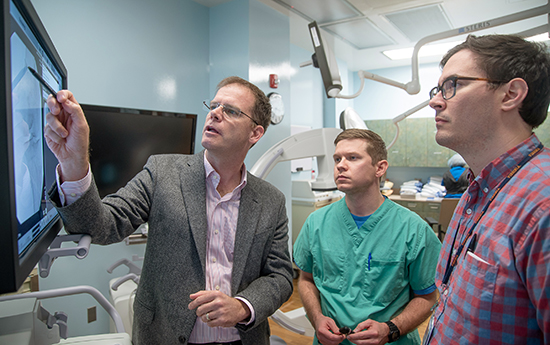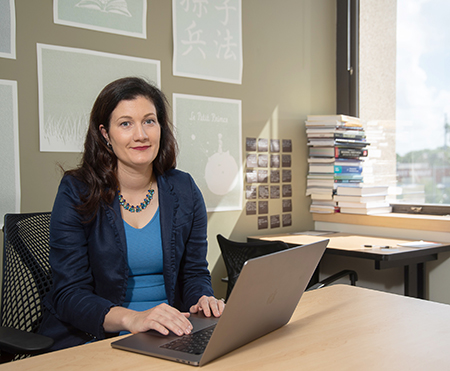
America has a problem with pain and a love of prescription painkillers.
In 2015, the number of opioids prescribed was enough for every American to be medicated for three weeks, according to the Centers for Disease Control and Prevention (CDC).
Opioids decrease pain perception, but they can also cause respiratory depression and addiction, even when taken as prescribed. The CDC reports that more than 200,000 people died in the U.S. from 1999 to 2016 from opioid-related overdoses with more than 63,000 deaths in 2016 alone.
It’s a sobering statistic that is giving medical professionals pause and has communities attempting to respond.
But despite the widespread availability of prescription painkillers, an underlying truth remains:
America is a country struggling with pain. Studies show that Americans experience more pain than other countries, and that we also perceive and report pain differently .
“Pain threads through most disease entities that are seen in an acute-care hospital or on the outpatient basis,” says Robert Hurley, MD, PhD, professor of anesthesiology and public health for Wake Forest School of Medicine and executive director of the Pain Shared Service Line for Wake Forest Baptist Medical Center. “Pain is the No. 1 reason for a patient coming to the ED and the No. 1 reason for coming for clinical visit.”
With the opioid crisis sweeping the country, researchers at the School of Medicine created the Center for Research on Substance Use and Addiction two years ago.
 Michael Nader, PhD, a professor of physiology and pharmacology, is co-director of the Center along with Mark Wolfson, PhD, professor of social sciences and health policy.
Michael Nader, PhD, a professor of physiology and pharmacology, is co-director of the Center along with Mark Wolfson, PhD, professor of social sciences and health policy.
The Center offers translational research pilot awards for competitive studies focusing on preclinical models, population research and clinical-translational research. Established for School of Medicine researchers, the Center encourages multidepartmental and collaborative projects.
Nader studies how drugs affect the brain while Wolfson researches the role of public policy as it relates to drug use and abuse.
“As you can see, we have very diverse backgrounds,” Nader says. “That’s one of the hallmarks of our Center. The goal is to get basic scientists, clinicians and researchers in the same room to talk about a common problem, and there are a lot of people at this institution who are interested in substance abuse research.”
“Yes, there are,” Wolfson interjects. “We have 66 members.”
Not only can the researchers impact each other’s work, but it’s this type of collaboration that can result in breakthroughs.
“That’s really the main focus of the center,” Nader says.
Given the scope of the opioid epidemic in the U.S., a lot of the Center’s energy focuses on finding solutions to the crisis. Center members are working on a variety of opioid studies, including the effectiveness of organized community strategies, peer-support programs, pain-management alternatives and experimental analgesics.
Community-Based Solutions
One approach to dealing with the opioid epidemic is to reduce the supply in households with organized disposal efforts such as drop boxes or take-back events.
 “But we’re a little skeptical of how well they work,” admits Wolfson. “There’s a reservoir in people’s medicine’s cabinets that can be stolen, used by adolescents or misused in any number of ways.”
“But we’re a little skeptical of how well they work,” admits Wolfson. “There’s a reservoir in people’s medicine’s cabinets that can be stolen, used by adolescents or misused in any number of ways.”
Working jointly with the University of Kentucky, Wolfson’s research focuses on whether improved messaging and better campaigns can increase community participation in organized disposal programs.
Wolfson also works with the N.C. Department of Health and Human Services to study the effectiveness of substance abuse prevention priorities such as media campaigns and physician training for responsible prescribing.
“We’re studying whether or not these programs work,” Wolfson says.
Preventing and Treating Addiction
Appropriate prescribing is also an interest of Hurley, who discusses his research while seated in his modest office, surrounded by stacks of books and medical journals. In front of him, there are two large dry erase boards filled with brown and purple notations, a stark contrast to the surrounding white walls. Words and numbers are scattered on the boards, the beginning stages of potential opioid-related studies, Hurley reveals.
Through his work with the Pain Shared Service Line, Hurley collaborates with physicians and clinicians across the institution to try and practice in a more similar fashion regarding pain.
And the reality is that pain is often adequately managed without narcotic prescriptions.
“There are many different ways to provide excellent pain care that do not involve an opioid,” Hurley says.
NSAIDs, Tylenol and other treatments can be far more effective in managing pain.
“In many studies, Toradol, for example, has been shown to be much more effective than morphine in similar dosages,” Hurley notes.
Treating non-cancer-related chronic pain often requires discussions with patients that opioids, because of their addictive nature, can have a negative impact.
“My major goal here is to provide the highest quality pain care for our patients while reducing harm,” Hurley says.
Hurley work focuses on three realms—clinical, research and education. “I do team-based collaborative research primarily focused on pain, pain care and pain education. So, it is both the treatment of patients, but it’s also research on improving our educational modalities and approaches for physicians, clinicians and medical students,” Hurley says .
 One of Hurley’s current research projects came out of a grant he received for being named a Robert Wood Johnson Clinical Scholar, a prestigious program that selects only 29 scholars a year. Scholars use their clinical expertise and research methods to help find solutions to problems facing the U.S. health care system.
One of Hurley’s current research projects came out of a grant he received for being named a Robert Wood Johnson Clinical Scholar, a prestigious program that selects only 29 scholars a year. Scholars use their clinical expertise and research methods to help find solutions to problems facing the U.S. health care system.
PROMPT: Prevention of Opioid Misuse Through Peer Training is a study led by Syed Ahmed, MD, DrPH, at the Medical College of Wisconsin.
“It’s an interesting project because it revolves around a large problem that is very hard to address,” Hurley says. “It’s the veteran population but veterans with opioid-related problems who do not trust the VA system or any health care provider.”
However, they do trust other veterans who have recovered from opioid addiction, and so the project addresses opioid misuse through a peer counseling network within Dryhootch, a nonprofit that provides mentoring services from veterans to veterans.
The goal is to prevent opioid misuse and deaths by training mentors on a specialized opioid curriculum, Hurley says.
“If this approach is deemed effective, it can be expanded to other communities.”
Understanding Pain
Researchers are also studying how people respond to pain differently.
“People having pain is normal,” says Meredith Adams, MD, associate professor of anesthesiology for the School of Medicine.
“There’s no such thing as no pain,” Adams notes. “Let’s say an Olympic athlete is immobile for two weeks, when he starts moving again, there will be pain, and that’s expected.”
Adams also says that opioids can also give patients a heightened sensitivity to pain. “It’s called opioid-induced hyperalgesia,” says Adams.
She characterizes the opioid epidemic as a “crisis of hope.”
“A lot of the communities that are most impacted by the crisis are also economically depressed,” Adams says. “Opiates are good at treating pain to a certain extent, but they also treat emotional pain.”
 Adams treats patients for acute and chronic pain, but the majority of her work is identifying opioid treatment response phenotypes in low back pain.
Adams treats patients for acute and chronic pain, but the majority of her work is identifying opioid treatment response phenotypes in low back pain.
“I’m studying who does well on medication and who doesn’t,” Adams says.
The research involves building infrastructure to do big data analytics in patient health records.
“When you go to the doctor and say, ‘I was feeling better when I did this’ or ‘It hurt when I did that,” there isn’t an easy way to extract that information for analysis,” Adams says. “So, I’m doing something called machine learning and natural language processing, which are ways of having a computer analyze that text data."
Adams admits that big data alone isn’t going to solve the crisis, but she’s laying a foundation to see where patterns emerge and to have a better understanding of how populations respond.
“I’m building the infrastructure for future studies—whether it’s genomic or predictive modeling,” Adams says.
Adams is hopeful that with a better understanding how populations respond, we can work toward preventing addiction.
“We can catch people before they go down the addiction pathway.”
